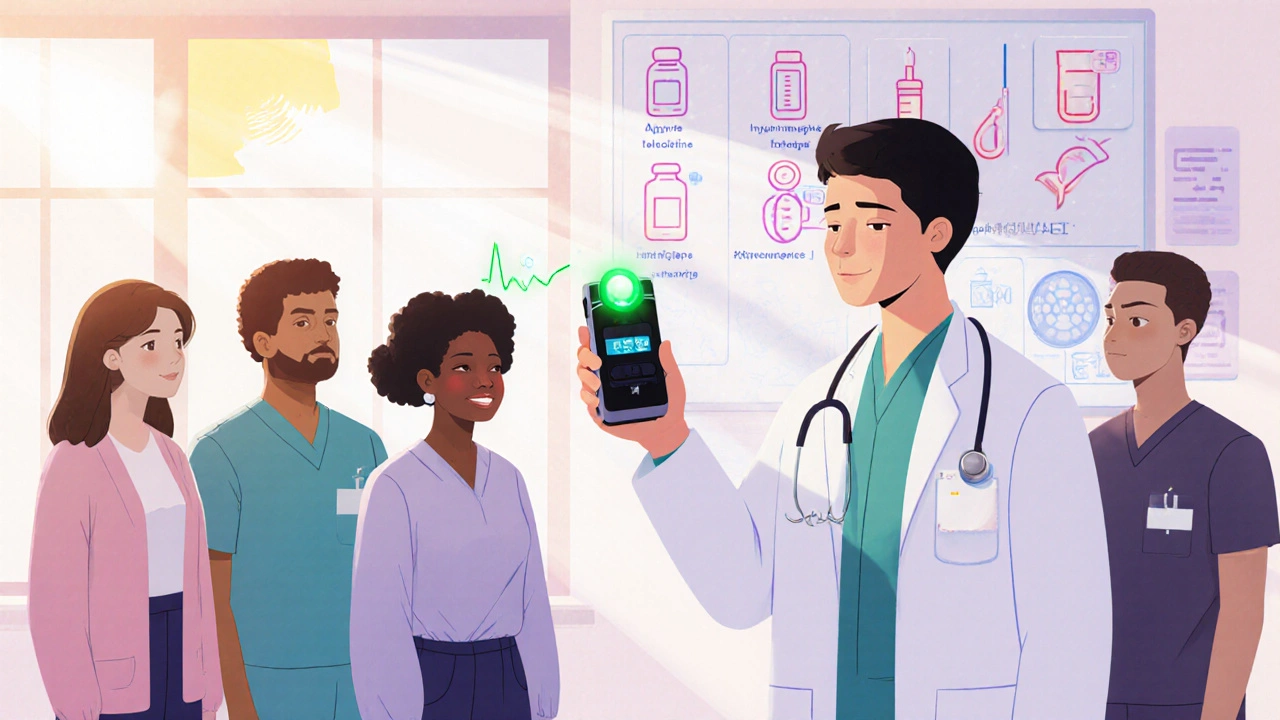Codeine Overdose Risk Calculator
Calculate Morphine Concentration
Enter codeine dose and metabolizer type to estimate potential morphine concentration and risk level.
Imagine giving a single dose of Codeine is an opioid pro‑drug that relies on the enzyme CYP2D6 to turn into its active form, morphine. For most people that conversion is modest, but for a small genetic subgroup the process explodes. These CYP2D6 ultrarapid metabolizer carries multiple functional copies of the CYP2D6 gene, making the body churn out morphine 3‑ to 4‑fold faster than normal. The result? codeine overdose risk that can turn a routine prescription into a life‑threatening emergency.
Why the Genetics Matter
The CYP2D6 enzyme is the gatekeeper that converts codeine (inactive) into morphine (active). Ultrarapid metabolizers typically have genotypes like *1/*1xN, *1/*2xN or *2/*2xN, giving them an activity score above 2.25. In practical terms, a 30 mg dose of codeine that would produce a safe 3‑5 ng/mL morphine concentration in a normal metabolizer can push a UM into 15‑20 ng/mL - well beyond the therapeutic window.
Regulatory Red Flags
In 2013 the FDA issued a safety communication after reviewing 64 serious case reports, 24 of which were deaths. The boxed warning now on every codeine label bluntly states that “respiratory depression and death have occurred in children who received codeine and were CYP2D6 ultrarapid metabolizers.” Similar warnings followed in the UK, New Zealand, and the EU.
Clinical Guidelines Speak Loudly
The Clinical Pharmacogenetics Implementation Consortium (CPIC) in its 2020 update says: *"codeine or tramadol should not be used for individuals with a CYP2D6 activity score >2.25"*. The Dutch Pharmacogenetics Working Group (DPWG) echoes this, recommending non‑CYP2D6‑dependent opioids such as morphine, hydromorphone or fentanyl for UMs.
How Overdose Shows Up
Symptoms can be subtle at first - nausea, excessive drowsiness, trouble waking - but they progress quickly to respiratory depression, hypoxia, and sometimes cardiac arrest. Blood morphine levels in reported fatal cases often exceeded 30 ng/mL, far above the 10‑15 ng/mL range considered safe for most adults.
Alternatives that Keep You Safe
Because codeine’s risk is tied to CYP2D6, swapping to an opioid that bypasses this pathway is the simplest fix. Below is a quick comparison.
| Drug | Metabolic Pathway | Key Advantage for UMs | Typical Dose (adult) |
|---|---|---|---|
| Codeine | CYP2D6 → morphine | None - high conversion risk | 30 mg q4‑6h PRN |
| Hydromorphone | Direct opioid | No CYP2D6 dependence | 2‑4 mg q4‑6h PRN |
| Fentanyl (transdermal) | Lipid‑soluble, metabolized by CYP3A4 | Bypasses CYP2D6 entirely | 12‑25 µg/h patch |
| Morphine | Direct opioid, minor glucuronidation | Predictable PK, no CYP2D6 activation | 5‑10 mg q4‑6h PRN |
Genetic Testing - How to Get It Done
Testing for CYP2D6 status is now offered by most clinical labs. Turn‑around times range from 3 to 14 days, with costs between $200‑$500. Some centers use point‑of‑care platforms that promise results within 2 hours - still emerging but promising for urgent surgeries.
Practical Steps for Clinicians
- Identify patients who may need codeine (post‑operative pain, cough suppression).
- Check if a CYP2D6 result is already in the EHR. If not, order a test before prescribing.
- If the activity score is >2.25, switch to a non‑CYP2D6 opioid or a non‑opioid analgesic (e.g., NSAIDs, acetaminophen).
- Document the decision and educate the patient on signs of opioid toxicity.
- For pediatric cases, avoid codeine entirely - the FDA and American Academy of Pediatrics both advise against it.

Who Is Most at Risk?
Ethnicity influences prevalence: about 3‑7 % of Europeans, up to 29 % of North Africans and Ethiopians, and 1‑2 % of East Asians carry the ultrarapid genotype. This means in multicultural societies the risk isn’t evenly spread - clinicians should keep demographic cues in mind.
Common Misconceptions
Some providers think “only a few patients will have a problem, so testing isn’t worth it.” The data says otherwise - in the FDA’s 64‑case review, 21 of the 24 deaths were in children, many of whom were UMs. Another myth is that a low dose of codeine is safe for everyone. Even a standard 15‑mg dose can be lethal for a UM because the conversion rate is exponential, not linear.
Future Outlook
With rapid genotyping on the horizon and growing awareness, codeine may soon be relegated to a historical footnote. Studies from Vanderbilt suggest point‑of‑care results within two hours could be routine by 2027, making pre‑emptive testing part of standard peri‑operative work‑ups.
What is a CYP2D6 ultrarapid metabolizer?
A CYP2D6 ultrarapid metabolizer has multiple functional copies of the CYP2D6 gene, giving an activity score >2.25. This boosts the conversion of codeine to morphine by 3‑ to 4‑fold, raising overdose risk.
Why is codeine dangerous for children who are ultrarapid metabolizers?
Children have smaller airways and lower respiratory reserves. When a CYP2D6 UM child receives codeine, the rapid surge of morphine can cause sudden respiratory depression, a leading cause of the documented fatalities.
Can I use a lower dose of codeine to avoid problems?
No. The conversion rate is not dose‑dependent; even low doses can produce toxic morphine levels in a UM.
Which opioids are safe for CYP2D6 ultrarapid metabolizers?
Opioids that do not rely on CYP2D6, such as morphine, hydromorphone, and fentanyl, are considered safe. Non‑opioid analgesics (NSAIDs, acetaminophen) are also good first‑line options.
How long does a CYP2D6 genetic test take?
Standard lab tests return results in 3‑14 days. Emerging point‑of‑care platforms aim for 2‑hour turnaround, but they are not yet widely available.







5 Comments
Great reminder to check CYP2D6 status before prescribing codeine. It’s a simple test that can prevent serious complications. Thanks for pulling the data together in one place.
Interesting breakdown of the metabolic pathways. I appreciate the clear tables, though a little more detail on alternative dosing would help. Also, the mention of point‑of‑care testing piqued my interest. It seems like the field is moving fast, but implementation hurdles remain. Overall a solid overview.
The exposition adheres to a rigorous standard of pharmacogenomic discourse, yet it conspicuously omits a comprehensive critique of the underlying methodological heterogeneity across cited case reports. Such an omission may inadvertently propagate a veneer of unanimity that belies the nuanced reality of clinical pharmacogenetics. A more discerning appraisal would enhance scholarly fidelity.
Codeine for UMs is a gamble and not worth the risk.
Ah, the joys of pharmacogenomics-where a single nucleotide can turn a modest analgesic into a lethal missile. When you hand a CYP2D6 ultrarapid metabolizer a 30 mg tablet of codeine, you’re essentially flooding their system with morphine at a three‑to‑four‑fold amplification rate. That pharmacokinetic surge translates into plasma morphine concentrations that dwarf the therapeutic window, instantly shifting the risk‑benefit balance toward catastrophe. The FDA’s boxed warning isn’t a mere suggestion; it’s a hard stop that reflects hard‑won, albeit tragic, clinical data. Pediatric cases, in particular, underscore how diminutive airway diameters and limited respiratory reserve magnify the danger. Genotype‑guided prescribing eliminates this guesswork, allowing clinicians to pivot to non‑CYP2D6 opioids like morphine or hydromorphone without compromising analgesia. The CPIC guidelines, while crystal‑clear, still battle inertia in real‑world practice, where legacy habits cling stubbornly. Point‑of‑care genotyping promises a turnaround of two hours, yet its adoption remains hampered by cost and workflow integration challenges. Nevertheless, the momentum is undeniable-by 2027 we may see pre‑emptive panels as routine as a CBC. Meanwhile, the comparative table you included does a stellar job of juxtaposing dose equivalencies, allowing for rapid decision‑making at the bedside. Remember, morphine’s glucuronidation pathway is far less variable than CYP2D6, delivering a predictable pharmacodynamic profile. Fentanyl patches, while potent, require meticulous dosing calculations but spare the metabolic bottleneck entirely. In the grand scheme, this is a classic case where precision medicine outperforms one‑size‑fits‑all prescribing. It also highlights the ethical imperative to inform patients about their genetic risk-transparency fosters trust. Ultimately, the goal is simple: avoid turning a routine prescription into a near‑miss or, worse, a fatality. So, let’s embrace genotype‑guided therapy and keep our patients safe.
Write a comment